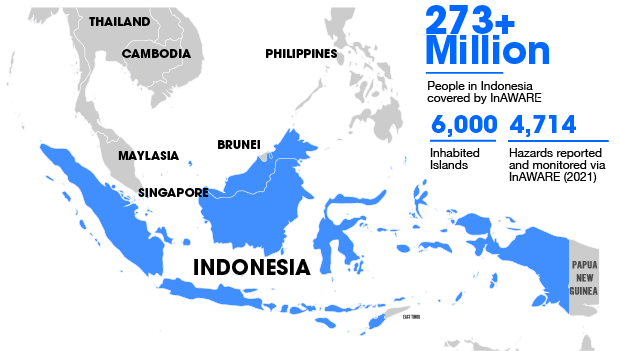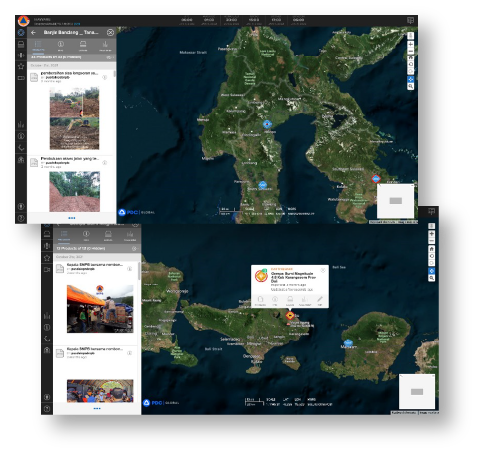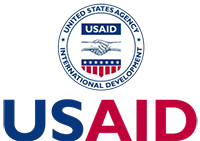A Case Study on National Disaster Risk Reduction


Scroll
Flooding and landslides in Luwu in early October 2021 were followed by a M4.8 earthquake in Bali less than two weeks later. For the national government of Indonesia, responding to complex and concurrent disasters such as this is not an uncommon scenario. Disaster managers need critical, life-saving information to aid rapid response during large-scale hazards that present potentially devastating impacts. That is why they rely on InAWARE, a customized version of PDC’s powerful DisasterAWARE platform that is used by Indonesia’s National Disaster Management Organization (NDMO) to monitor and respond to hazard events. InAWARE helps decision makers answer key questions like: What happened? Where did it happen? How bad is it? What actions need to be taken?
The system is used at both the national level, by Indonesia’s NDMO known as Badan Nasional Penanggulangan Bencana (BNPB), down to the provincial level—allowing islands to communicate with one another.
“With this application, we can determine an action plan for how to handle a disaster or assist with post-disaster recovery.”
–Bambang Surya Putra
Head of Indonesia’s Emergency Operations Center

Disaster managers used InAWARE for life-saving information to aid rapid response during large-scale hazards such as flooding in Luwu (above, top) and an earthquake in Bali (above, bottom), both in October 2021.
InAWARE aids quick and effective actions which save lives and protect against losses
According to Bambang Surya Putra, head of BNPB’S Emergency Operations Center, the importance of InAWARE is both underscored by the nation’s current disaster profile, and the imminent challenges posed by climate change—including an ever-increasing frequency and severity of disasters.
Compounding these challenges is the geological makeup of the country as an archipelago with more than 6,000 inhabited islands and more than 273 million people dispersed across them. The logistical complexity of planning and orchestrating a disaster response that can adequately reach remote population centers is unlike what most disaster management teams face in landlocked regions. In the age of COVID-19 these challenges are only made worse.
“The information and data contained in InAWARE is very helpful for disaster management practitioners to understand the situation and conditions in disaster-affected areas,” Bambang said while assisting with the aftermath of the deadly Mount Semeru eruption in early December 2021.
InAWARE supports critical early warning and monitoring of multiple hazards ranging from volcanoes and earthquakes to floods and landslides. This capability is imperative for a country ranked 10th highest in the world for multi-hazard risk according to PDC’s global risk and vulnerability assessment.
The InAWARE system supplies decision makers with real-time hazard information as well as other critical national data to help assess the demographic impacts and needs of those likely to be affected. It also helps anticipate the extent of the damage. This is made possible through multiple data contributors and robust automated modeling built into the system. The speed and accuracy with which an analysis can be performed in the system is perhaps the most important capability. Saving time equates to saving lives, protecting livelihoods, and ultimately reducing suffering.
In addition, the foundation of any solid disaster management plan involves a multitude of partners and a coordinated effort. Through InAWARE, responders and decision makers from across disciplines can upload data and share situational awareness products as well as collaborate on multilateral delivery of humanitarian aid.
InAWARE Impact Summary
InAWARE was launched in 2014 in partnership between Indonesia and PDC, through funding support from USAID’s Office of Foreign Disaster Assistance (now known as the Bureau of Humanitarian Affairs), and has served the nation’s disaster management needs ever since.
4,700+
Total hazards added to InAWARE (2021)
1,182
Hazards added by BNPB
15
Hazards added by Indonesia’s Center for Volcanology CVGHM
71%
Automated Hazards
171
Hazards added by BPBD provincial offices
3,100+
Hazards supplemented by PDC via authoritative global data sources
29%
Hazards reported by Staff
228
Hazards added by Indonesia’s Meteorological Agency BMKG
13
Provincial BPBD offices using InAWARE
900+
Data Layers
Growth in Utilization of InAWARE
2019 versus 2021
Active participation by Indonesia’s provincial disaster management offices have increased overall utilization of InAWARE over the past two years, including the number of hazards reported in the system.
53
Hazards added (November 2019)
200
Hazards added (November 2021)
 | ASEAN | Regional and National Capacity Development for Hazard Monitoring, Early Warning and Disaster Management Decision Support
| ASEAN | Regional and National Capacity Development for Hazard Monitoring, Early Warning and Disaster Management Decision Support
Want to speak with someone about our capabilities or DisasterAWARE technology?
